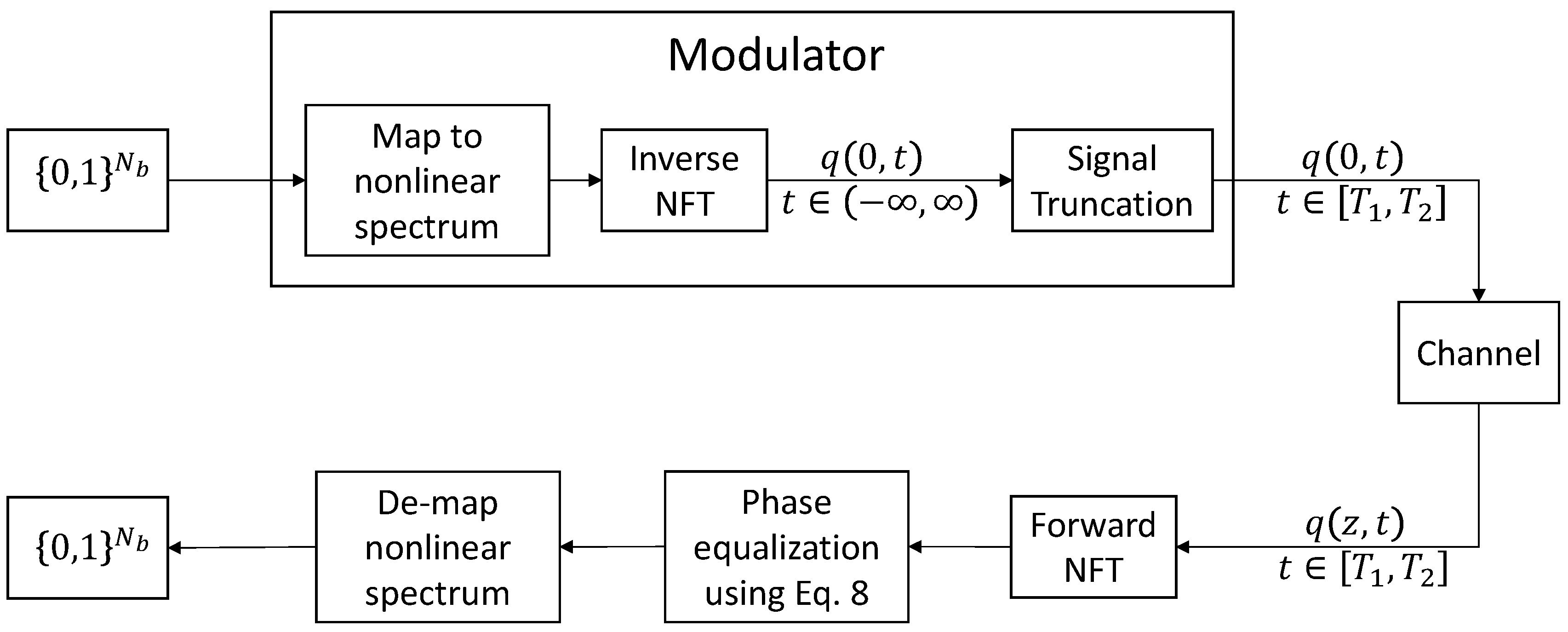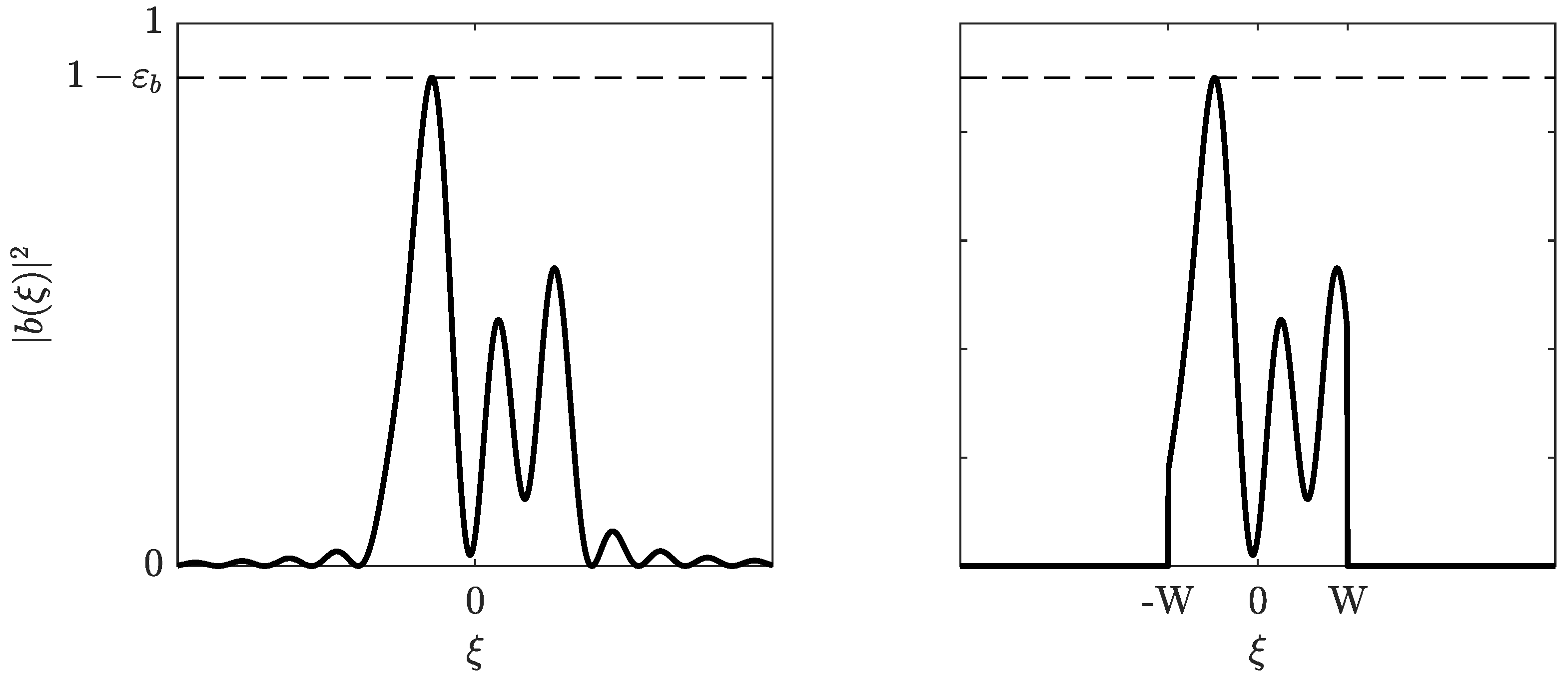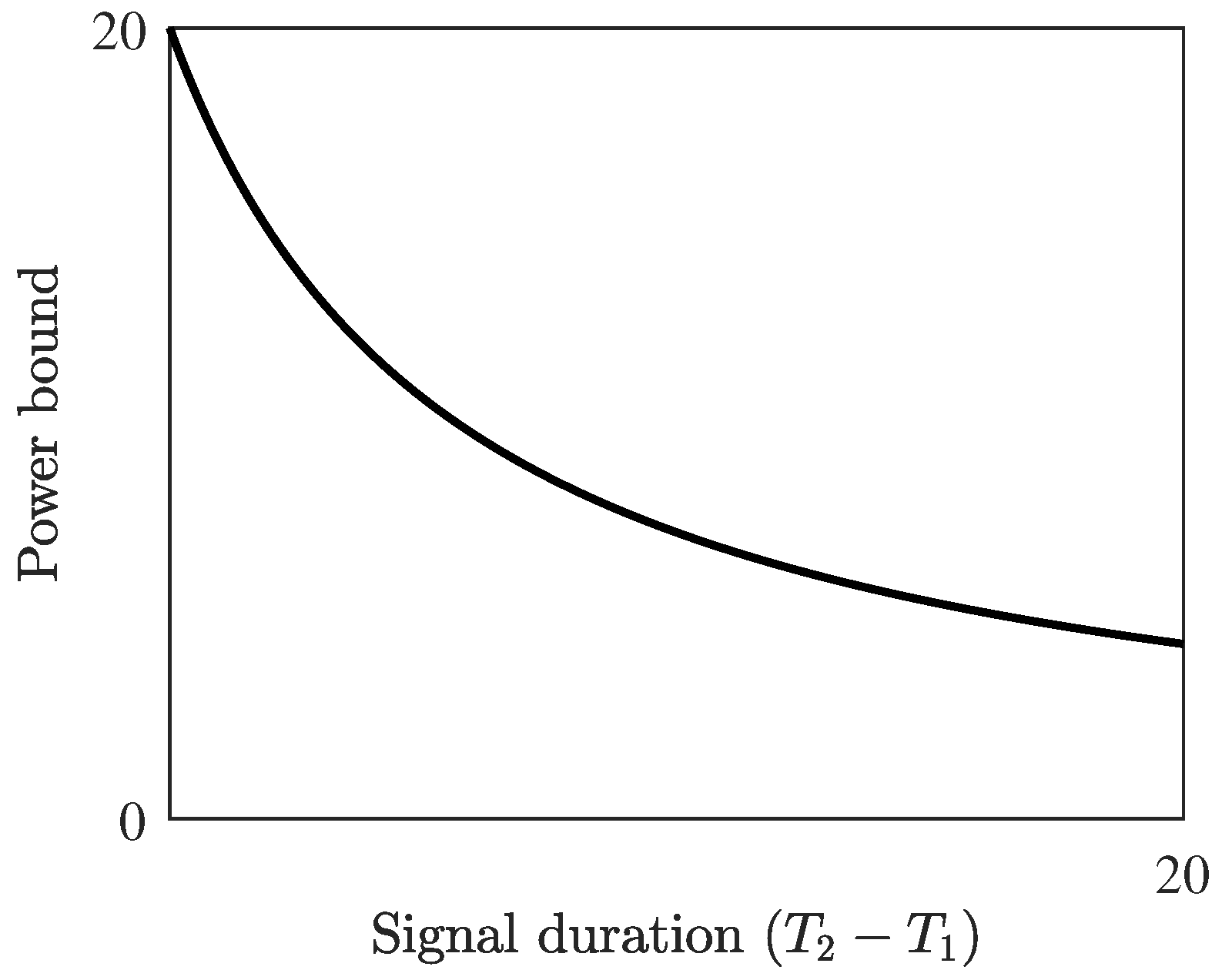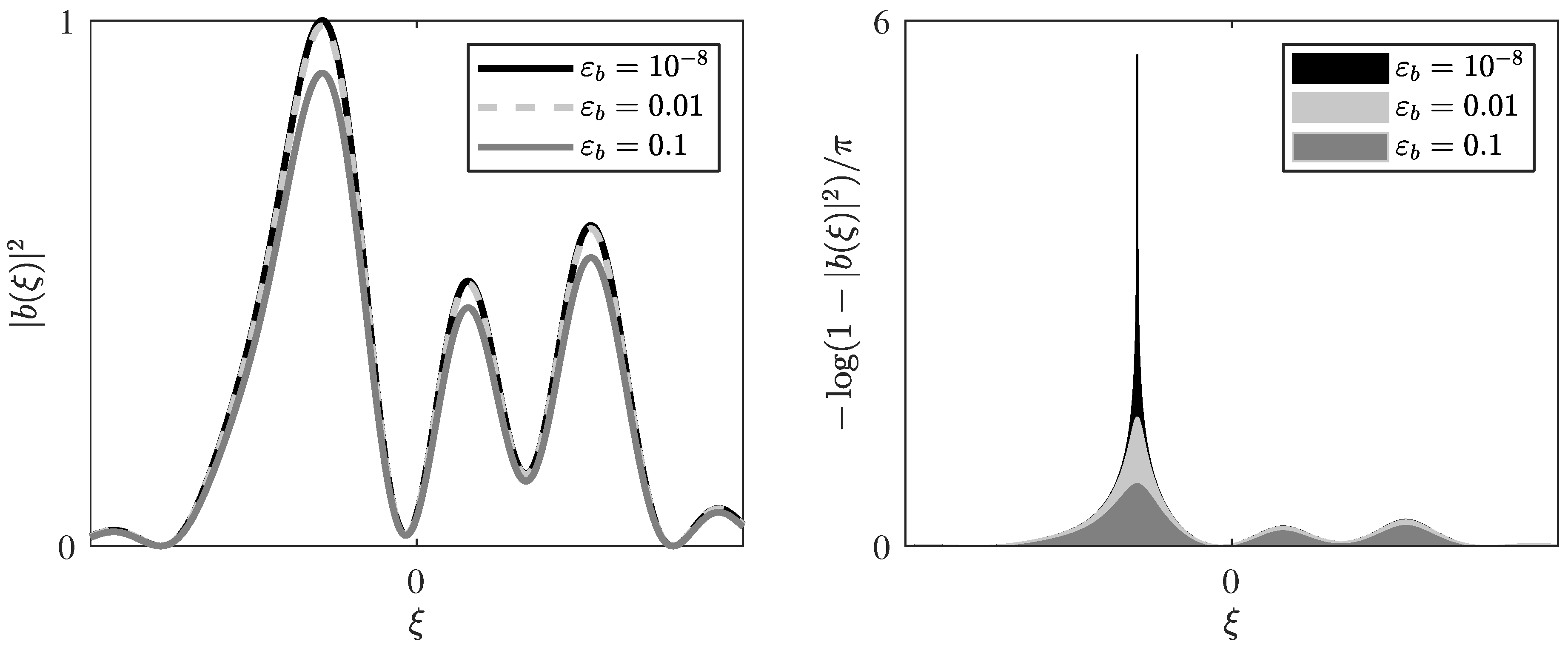Bounds on the Transmit Power of b-Modulated NFDM Systems in Anomalous Dispersion Fiber
Abstract
:1. Introduction
Notation
2. Review of NFDM
2.1. Nonlinear Fourier Transform for Vanishing Signals
2.2. NFDM Signal Generation
3. Upper Bounds on the Transmit Power of b-Modulators
3.1. Power Bound for a Fixed Gap to Singularity
3.2. Uniform Power Bound for Arbitrary Gaps to Singularity
4. Conclusions
Author Contributions
Funding
Conflicts of Interest
Abbreviations
| NFT | Nonlinear Fourier Transform |
| NFDM | Nonlinear Frequency Division Multiplexing |
References
- Zakharov, V.; Shabat, A. Exact Theory of Two-Dimensional Self-Focusing and One-Dimensional Self-Modulation of Waves in Nonlinear Media. Sov. Phys. JETP 1972, 34, 62. [Google Scholar]
- Agrawal, G.P. Chapter 5-Optical Solitons. In Nonlinear Fiber Optics, 5th ed.; Agrawal, G., Ed.; Optics and Photonics; Academic Press: Boston, MA, USA, 2013; pp. 129–191. [Google Scholar]
- Bajaj, V.; Chimmalgi, S.; Aref, V.; Wahls, S. Exact NFDM Transmission in the Presence of Fiber-Loss. J. Light. Technol. 2020, 38, 3051–3058. [Google Scholar] [CrossRef] [Green Version]
- Yousefi, M.I.; Kschischang, F.R. Information Transmission Using the Nonlinear Fourier Transform, Part I: Mathematical Tools. IEEE Trans. Inf. Theory 2014, 60, 4312–4328. [Google Scholar] [CrossRef] [Green Version]
- Prilepsky, J.E.; Derevyanko, S.A.; Blow, K.J.; Gabitov, I.; Turitsyn, S.K. Nonlinear Inverse Synthesis and Eigenvalue Division Multiplexing in Optical Fiber Channels. Phys. Rev. Lett. 2014, 113, 013901. [Google Scholar] [CrossRef] [PubMed] [Green Version]
- Turitsyn, S.K.; Prilepsky, J.E.; Le, S.T.; Wahls, S.; Frumin, L.L.; Kamalian, M.; Derevyanko, S.A. Nonlinear Fourier Transform for Optical Data Processing and Transmission: Advances and Perspectives. Optica 2017, 4, 307–322. [Google Scholar] [CrossRef] [Green Version]
- Le, S.; Aref, V.; Buelow, H. Nonlinear Signal Multiplexing for Communication Beyond the Kerr Nonlinearity Limit. Nat. Photonics 2017, 11. [Google Scholar] [CrossRef]
- Gaiarin, S.; Perego, A.M.; da Silva, E.P.; Ros, F.D.; Zibar, D. Dual-polarization Nonlinear Fourier Transform-based Optical Communication System. Optica 2018, 5, 263–270. [Google Scholar] [CrossRef] [Green Version]
- Goossens, J.W.; Yousefi, M.I.; Jaouën, Y.; Hafermann, H. Polarization-division Multiplexing Based on the Nonlinear Fourier transform. Opt. Express 2017, 25, 26437–26452. [Google Scholar] [CrossRef]
- Le, S.T.; Aref, V.; Buelow, H. High Speed Precompensated Nonlinear Frequency-Division Multiplexed Transmissions. J. Light. Technol. 2018, 36, 1296–1303. [Google Scholar] [CrossRef] [Green Version]
- Le, S.T.; Buelow, H. High Performance NFDM Transmission with b-modulation. In Proceedings of the 19th ITG-Symposium, Photonic Networks, Leipzig, Germany, 11–12 June 2018; pp. 1–6. [Google Scholar]
- Yangzhang, X.; Le, S.T.; Aref, V.; Buelow, H.; Lavery, D.; Bayvel, P. Experimental Demonstration of Dual-Polarization NFDM Transmission With b-Modulation. IEEE Photonics Technol. Lett. 2019, 31, 885–888. [Google Scholar] [CrossRef]
- Yu, R.; Zheng, Z.; Zhang, X.; Du, S.; Xi, L.; Zhang, X. Hybrid Probabilistic-Geometric Shaping in DP-NFDM Systems. In Proceedings of the 2019 18th International Conference on Optical Communications and Networks (ICOCN), Huangshan, China, 5–8 August 2019; pp. 1–3. [Google Scholar]
- Aref, V.; Le, S.T.; Buelow, H. Modulation Over Nonlinear Fourier Spectrum: Continuous and Discrete Spectrum. J. Light. Technol. 2018, 36, 1289–1295. [Google Scholar] [CrossRef]
- Da Ros, F.; Civelli, S.; Gaiarin, S.; da Silva, E.P.; De Renzis, N.; Secondini, M.; Zibar, D. Dual-Polarization NFDM Transmission With Continuous and Discrete Spectral Modulation. J. Light. Technol. 2019, 37, 2335–2343. [Google Scholar] [CrossRef]
- Zhou, G.; Gui, T.; Lu, C.; Lau, A.P.T.; Wai, P.A. Improving Soliton Transmission Systems Through Soliton Interactions. J. Light. Technol. 2019. [Google Scholar] [CrossRef]
- Aref, V.; Le, S.T.; Buelow, H. Does the Cross-Talk Between Nonlinear Modes Limit the Performance of NFDM Systems? In Proceedings of the 2017 European Conference on Optical Communication (ECOC), Gothenburg, Sweden, 17–21 September 2017; pp. 1–3. [Google Scholar]
- Civelli, S.; Forestieri, E.; Secondini, M. Why Noise and Dispersion May Seriously Hamper Nonlinear Frequency-Division Multiplexing. IEEE Photonics Technol. Lett. 2017, 29, 1332–1335. [Google Scholar] [CrossRef]
- Chimmalgi, S.; Wahls, S. Theoretical Analysis of Maximum Transmit Power in a b-Modulator. In Proceedings of the European Conference on Optical Communication, Dublin, Ireland, 22–26 September 2019; pp. 1–3. [Google Scholar]
- Civelli, S.; Forestieri, E.; Secondini, M. Nonlinear Frequency Division Multiplexing: Immune to Nonlinearity but Oversensitive to Noise? In Proceedings of the 2020 Optical Fiber Communications Conference and Exhibition (OFC), San Diego, CA, USA, 8–12 March 2020; pp. 1–3. [Google Scholar]
- Gui, T.; Zhou, G.; Lu, C.; Lau, A.P.T.; Wahls, S. Nonlinear Frequency Division Multiplexing with b-Modulation: Shifting the Energy Barrier. Opt. Express 2018, 26, 27978–27990. [Google Scholar] [CrossRef] [Green Version]
- Ablowitz, M.J.; Kaup, D.J.; Newell, A.C.; Harvey, S. The Inverse Scattering Transform-Fourier Analysis for Nonlinear Problems. Stud. Appl. Math. 1974, 53, 249–315. [Google Scholar] [CrossRef]
- Faddeev, L.D.; Takhtajan, L. Hamiltonian Methods in the Theory of Solitons; Springer: Berlin/Heidelberger, Germany, 2007. [Google Scholar]
- Zhou, X. Direct and Inverse Scattering Transforms with Arbitrary Spectral Singularities. Commun. Pure Appl. Math. 1989, 42, 895–938. [Google Scholar] [CrossRef]
- Fagerstrom, E. On the Nonlinear Schrodinger Equation with Nonzero Boundary Conditions. Ph.D. Thesis, University of Buffalo, Buffalo, NY, USA, 2015. [Google Scholar]
- Wahls, S. Generation of Time-Limited Signals in the Nonlinear Fourier Domain via b-Modulation. In Proceedings of the 2017 European Conference on Optical Communication (ECOC), Gothenburg, Sweden, 17–21 September 2017; pp. 1–3. [Google Scholar] [CrossRef] [Green Version]
- Gemechu, W.A.; Song, M.; Jaouen, Y.; Wabnitz, S.; Yousefi, M.I. Comparison of the Nonlinear Frequency Division Multiplexing and OFDM in Experiment. In Proceedings of the 2017 European Conference on Optical Communication (ECOC), Gothenburg, Sweden, 17–21 September 2017; pp. 1–3. [Google Scholar]
- Gemechu, W.A.; Gui, T.; Goossens, J.; Song, M.; Wabnitz, S.; Hafermann, H.; Lau, A.P.T.; Yousefi, M.I.; Jaouën, Y. Dual Polarization Nonlinear Frequency Division Multiplexing Transmission. IEEE Photonics Technol. Lett. 2018, 30, 1589–1592. [Google Scholar] [CrossRef]
- Ablowitz, M.; Segur, H. The Inverse Scattering Transform on the Infinite Interval. In Solitons and the Inverse Scattering Transform; SIAM: Philadelphia, PA, USA, 1981. [Google Scholar]
- Wahls, S.; Chimmalgi, S.; Prins, P.J. Wiener-Hopf Method for b-Modulation. In Proceedings of the Optical Fiber Communications Conference and Exhibition (OFC), San Diego, CA, USA, 3–7 March 2019; pp. 1–3. [Google Scholar]
- Le, S.T.; Schuh, K.; Buchali, F.; Buelow, H. 100 Gbps b-modulated Nonlinear Frequency Division Multiplexed Transmission. In Proceedings of the 2018 Optical Fiber Communications Conference and Exposition (OFC), San Diego, CA, USA, 1–15 March 2018; pp. 1–3. [Google Scholar]
- Shepelsky, D.; Vasylchenkova, A.; Prilepsky, J.E.; Karpenko, I. Nonlinear Fourier Spectrum Characterization of Time-limited Signals. IEEE Trans. Commun. 2020, 68, 3024–3032. [Google Scholar] [CrossRef]
- Gearhart, W.B.; Shultz, H.S. The Function sin(x)/x. Coll. Math. J. 1990, 21, 90–99. [Google Scholar] [CrossRef]
- Andersen, N.B. Entire Lp-functions of Exponential Type. Expo. Math. 2014, 32, 199–220. [Google Scholar] [CrossRef]
- Duda, K.; Zieliński, T.P.; Barczentewicz, S.H. Perfectly Flat-Top and Equiripple Flat-Top Cosine Windows. IEEE Trans. Instrum. Meas. 2016, 65, 1558–1567. [Google Scholar] [CrossRef]
- Krantz, S.; Parks, H. Chapter “Elementary Properties”. In A Primer of Real Analytic Functions; Birkhäuser Verlag: Basel, Switzerland, 1992. [Google Scholar]





© 2020 by the authors. Licensee MDPI, Basel, Switzerland. This article is an open access article distributed under the terms and conditions of the Creative Commons Attribution (CC BY) license (http://creativecommons.org/licenses/by/4.0/).
Share and Cite
Chimmalgi, S.; Wahls, S. Bounds on the Transmit Power of b-Modulated NFDM Systems in Anomalous Dispersion Fiber. Entropy 2020, 22, 639. https://doi.org/10.3390/e22060639
Chimmalgi S, Wahls S. Bounds on the Transmit Power of b-Modulated NFDM Systems in Anomalous Dispersion Fiber. Entropy. 2020; 22(6):639. https://doi.org/10.3390/e22060639
Chicago/Turabian StyleChimmalgi, Shrinivas, and Sander Wahls. 2020. "Bounds on the Transmit Power of b-Modulated NFDM Systems in Anomalous Dispersion Fiber" Entropy 22, no. 6: 639. https://doi.org/10.3390/e22060639
APA StyleChimmalgi, S., & Wahls, S. (2020). Bounds on the Transmit Power of b-Modulated NFDM Systems in Anomalous Dispersion Fiber. Entropy, 22(6), 639. https://doi.org/10.3390/e22060639




